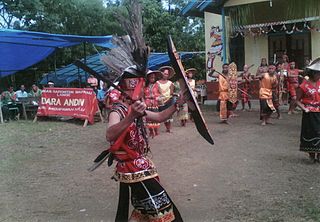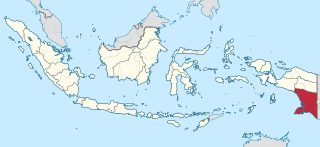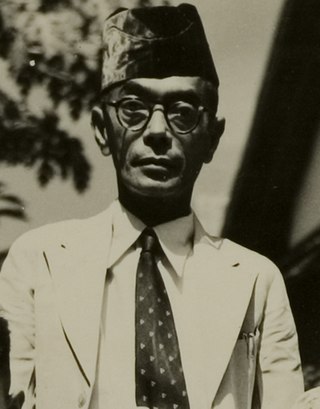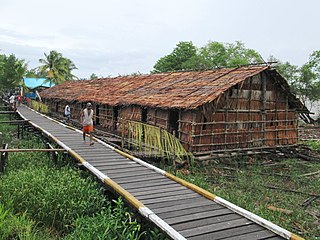
Malay houses refer to the vernacular dwellings of the Malays, an ethno-linguistic group inhabiting Sumatra, coastal Borneo and the Malay Peninsula.

The Agency for Language Development and Cultivation, formerly the Language and Book Development Agency and the Language Centre, is the institution responsible for standardising and regulating the Indonesian language as well as maintaining the indigenous languages of Indonesia. It is an agency under the Ministry of Education, Culture, Research and Technology of Indonesia.

The Arfak Mountains is a mountain range found on the Bird's Head Peninsula in the Province of West Papua, Indonesia.

The Kendayan are an Indonesian ethnic group native to Kalimantan, Indonesia in Borneo. The population of the group is around 366,000.

The National Intangible Cultural Heritage of Indonesia is a "living culture" that contains philosophical elements from the traditions of society and is still handed down from generation to generation. Edi Sedyawati added an important element in the notion of intangible cultural heritage is the nature of culture that cannot be held (abstract), such as concepts and technology, its nature can pass and disappear in time with the times such as language, music, dance, ceremony, and various other structured behaviors. Thus, cultural heritage is shared by a community or community and experiences development from generation to generation, in the flow of a tradition. The Ministry of Education and Culture of Indonesia records and establishes a list of intangible cultural heritage. As of June 2020, a total of 9,770 cultural heritages have been recorded and 1,086 of them have been designated.

Utuy Tatang Sontani was an Indonesian writer and university lecturer. He was born in Cianjur, West Java. In 1938 he attended an adult school in Bandung, and then became a civil servant. After the independence of Indonesia in 1945, he successively worked for National Broadcasting Station and Books Compilation & Translation Bureau. In 1959 he joined the People's Culture Association, and became a member of its central committee. He lived abroad after 1965, mainly in the Soviet Union, taught at Institute of Asian and African Countries at Moscow State University, died and was buried in Moscow.

Piper retrofractum, the Balinese long pepper or Javanese long pepper, is a flowering vine in the family Piperaceae, cultivated for its fruit, which is usually dried and used as a spice and seasoning. This species is native to Java island in Indonesia.

Rumah adat are traditional houses built in any of the vernacular architecture styles of Indonesia, collectively belonging to the Austronesian architecture. The traditional houses and settlements of the several hundreds ethnic groups of Indonesia are extremely varied and all have their own specific history. It is the Indonesian variants of the whole Austronesian architecture found all over places where Austronesian people inhabited from the Pacific to Madagascar each having their own history, culture and style.

Gorontalo people, also known as Gorontalese are a native ethnic group and the most populous ethnicity in the northern part of Sulawesi. The Gorontalo people have traditionally been concentrated in the provinces of Gorontalo, North Sulawesi, and the northern part of Central Sulawesi.

The Muna or Wuna are the indigenous group which primarily inhabit the islands of Buton and Muna. They speak languages from the Muna-Buton language group.

Rangkiang is a granary or rice barn that the Minangkabau people used to keep rice in. The rangkiang is a distinctive feature of Minangkabau architecture. The structure is traditionally found in the courtyard of a rumah gadang, the traditional house of Minangkabau people.

Banten Sundanese or Bantenese is one of the Sundanese dialects spoken predominantly by the Bantenese — an indigenous ethnic group native to Banten — in the westernmost region of the island of Java, and in the western Bogor Regency, as well as the northwestern parts of Sukabumi Regency. A variety of Bantenese is spoken by the Ciptagelar people in the Kasepuhan Ciptagelar traditional community in the Cisolok district and the Kasepuhan Banten Kidul traditional community in the Lebak Regency.

A balairung is a village hall of the Minangkabau people of West Sumatra, Indonesia. It has a similar architectural form to the rumah gadang, the domestic architecture of the Minangkabau people. Whereas a rumah gadang is a proper building, the balairung is a pavilion-like structure used solely for holding a consensus decision-making process in the Minang society.

South Papua, officially the South Papua Province, is an Indonesian province located in the southern portion of Papua, following the borders of the Papuan customary region of Anim Ha. Formally established on 11 November 2022 and including the four most southern regencies that were previously part of the province of Papua and before 11 December 2002 had comprised a larger Merauke Regency, it covers a land area of 129,715.02 km2, about the same area as Pennsylvania. This area had a population of 513,617 at the 2020 Census, while the official estimate as at mid 2023 was 537,973, making it the least populous province in Indonesia.

Bedil tombak or bedil tumbak is a type of early firearm from the Indonesian archipelago. The weapon consists of a gun or small cannon mounted on a wooden pole, forming a type of weapon known as "pole gun".

Sri Koesnapsijah was a Javanese language writer and activist of the Dutch East Indies and Indonesia who was among the generation of Indonesian women writers active in the 1930s. She was known for her short stories and articles which she published in the magazine Panjebar Semangat in the 1930s and 1940s, where she was also an assistant editor. After Indonesian independence she was active in the Communist Party-affiliated Gerwani movement, and was briefly a representative of the Communist Party in the Jakarta-area consultative body DPR-GR. She was arrested in late 1965 during the anti-communist repression of the Transition to the New Order and imprisoned without charge for the following decade.

Muhammad Kaharuddin III was an Indonesian politician and royal who was the 16th Sultan of Sumbawa, a senator of the United States of Indonesia, and the regent of Sumbawa Regency between 1959 and 1960. He was also active in the politics of the State of East Indonesia, where he chaired its legislature between 1947 and its dissolution in 1950.
Koestijah, who commonly published as Rara Koestijah was a Javanese language writer of the Dutch East Indies known primarily for the short stories she published in the 1930s and early 1940s in the magazine Panjebar Semangat. Her short stories dealt with themes of interpersonal moral conflicts, class difference, and marriage.

Southwest Papua is the 38th province of Indonesia to be created, and was split off from West Papua on 8 December 2022. Despite being named southwest, it is a misnomer and this province is actually located in the northwest edge of Papua. The province comprises the Greater Sorong area which consists of Sorong City, Sorong Regency, South Sorong Regency, Maybrat Regency, Tambrauw Regency, and Raja Ampat Regency. The Bill (RUU) on the Establishment of the Southwest Papua Province was passed into law and therefore it became the 38th province in Indonesia.

Jew, also known as the bachelor house, is an Asmat traditional house originating from the Asmat Regency, particularly from Agats. Jew, also known by several other names such as Je, Jeu, Yeu, or Yai, is a rectangular elevated house made of wood, with walls and roofs made of woven sago palm or nipa palm leaves. Jew entirely avoids using nails and uses rattan roots as connectors instead.





















